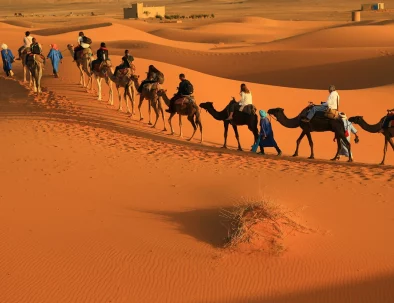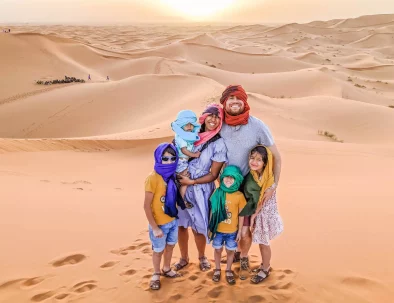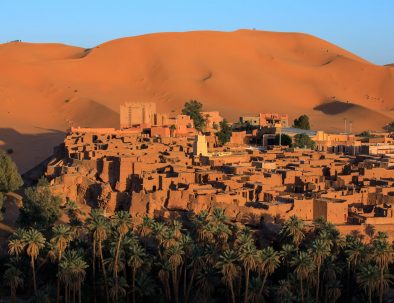Day 1: An evening in Casablanca
Welcome to Morocco’s western coast! Upon arrival, take a taxi to your hotel in Casablanca. Depending on the specifics of your flight, you might have some free time to look around. Take a stroll to the Hassan II Mosque along the Boulevard de la Corniche, the beach promenade that follows the Atlantic and is frequently referred to as Morocco’s “Miami.” Even though only morning tours are available inside, take advantage of the time and observe the architectural wonder as the sun sets. Eat something at Rick’s Café, a restaurant, bar, and café built to look like the bar in the iconic film Casablanca.
Day 2: Hassan II Mosque and historic Meknes
The breathtaking Hassan II Mosque is located in Casablanca, the country of Morocco’s modern and commercial capital. It is the tallest building in Morocco and has the tallest minaret in the world, standing at 690 feet (210 meters) above the Atlantic. An estimated 80,000 worshipers could fit in the interior, according to estimates. The fact that this mosque is one of the few in the nation that non-Muslims can enter gives it a special distinction. Join a tour in the morning to marvel at the exquisitely ornate craftsmanship, including the hand-carved stone and wood, the minute marble floor details, and the gilded cedar ceilings.
Leave the coast behind and head east to Meknes, the first historic imperial city you will encounter. Meknes is a smaller, less hectic version of Fes, where shopkeepers are less pushy to make a sale. In the Ville Impériale, see the magnificent Bab al-Mansour gate and the Mausoleum of Moulay Ismail (Imperial City). Before visiting the Madrasa Bou Inania, stroll through the old quarter’s Medina and souks (14th century). The madrasa (Islamic school), a stunning example of Islamic architecture, offers lovely views from its rooftop. Don’t forget to visit Dar Jama, a former palace turned Museum.
Day 3: The Blue City of Chefchaouen
After breakfast, travel a short distance to the impressive Volubilis in the direction of the north. Volubilis is a vast complex that has been extraordinarily well preserved for centuries and is a UNESCO World Heritage Site. It was one of the most remote regions of the Roman Empire when it was founded in the third century BCE and was a thriving city in its day before it was abandoned nearly a thousand years later. Admire the merchant houses with their obvious heating systems, the temples, and the vibrant, almost-completely-intact in-place mosaics, such as the Labors of Hercules.
Continue travelling north and observe how the landscape transforms from flat plains and rolling hills to the rocky Rif Mountains. Enjoy the laid-back atmosphere and welcoming locals in Chefchaouen, also called the “Blue City,” which comprises winding, narrow streets and blue-washed buildings. Before visiting the kasbah, spend some time in the small Medina along the northern hillside and eat in Plaza Outa el Hammam (old fortification). Make your way to the deserted Spanish Mosque as the day ends to take in one final view of Chefchaouen as the sun sets behind the mountains.
Day 4: Chefchaouen to Fes
Before travelling south to your second imperial city, Fes, get up early to take clear pictures of the blue-hued streets. Fes is a city where getting lost is worthwhile due to its impressively large and intricate medinas. Spend some time at the Merenid Tombs, north of the city, to enjoy the panoramic views of ancient Fes and the surroundings before going into the medina. On warm rocks, you might even see leather hides drying. To locate a café for a late lunch, descend the hill and enter Fes el Bali through the renowned Bab Boujeloud gate.
Continue your leisurely exploration of Fes before returning to your traditional riad for a hearty meal and settling in for the evening.
Days 5: Fes: Exploring the Imperial City and medieval Medina
Of Morocco’s four Imperial Cities, Fes is the oldest and, arguably, the most fascinating and exciting to explore. It was established over a thousand years ago and had a complete Medina in the Arab world. Fes el Bali and Fes el Jdid, two medina quarters, and Ville Nouvelle, a more contemporary area with French colonial influences, make up what is frequently referred to as the nation’s cultural capital. As you travel through the winding streets of the medinas, meet your guide and spend a half day learning about the history and culture of the region.
Start in Fes el Bali at the Bab Boujeloud gate and proceed into Talâa Kebira’s main street. As you pass stores and souks, take note of the architecture that has influences from Tunisia and Spain. The tanneries in the old Medina are among the most distinctive sights, and Chouara Tannery is no exception. Then, ascend to the roof of a nearby leather store for a better view of the men still using age-old methods while working with stone pots filled with dye from the 11th century.
Next, proceed to the 14th-century Al Attarine Madrasa, a stunning display of Moroccan craftsmanship and architecture that features intricate zellij tilework. From there, proceed to Al-Qarawiyyin University (859 CE), one of the world’s oldest still-open universities. It is located next to the Al-Qarawiyyin Mosque. There are a few locations where you can glimpse the mosque’s elaborate interior, even though it is only accessible to Muslims. Before turning in for the night, foodies might also want to enrol in a cooking class to learn how to make a typical Moroccan meal.
Day 6: Fes: Museums, Ceramics and Tile Collective, and gardens
Visit the Batha Museum today. The Museum is home to a collection of traditional Moroccan arts and crafts, including carved wood, zellij, and regional pottery. It is housed in a 19th-century palace (its highlight). Visit the gardens in the style of Andalusia before proceeding to the Mellah (old Jewish quarter and cemetery). Utilize its location to capture a breathtaking panoramic image of the city. Discover the striking difference in architecture by travelling further south to Ville Nouvelle.
Visit a ceramics and tile collective to discover the entire manufacturing process, from sculpting the clay to painting the designs on the products. Additionally, you can observe the tile craftsmen as they create intricate mosaics by assembling tiny pieces of tile. As you head back in the direction of Fes el Bali, pause at Jnan Sbil (Bou Jeloud Gardens), which is midway between the Mellah and Bab Boujeloud. Spend some time unwinding in the splendour of the gardens, then cool off in the main fountains or by the lake.
Day 7: Middle Atlas: Erfoud, Merzouga and the Sahara
To reach the Sahara dune area in time for a camel ride at sunset, start your day early and head south toward Merzouga. You will ascend 7,146 feet (2,178 m) in elevation along the way, crossing the Col du Zad pass and passing through Middle Atlas mountain cedar forests. Before stopping for lunch in Midelt (the “apple city”), enjoy seeing the local Barbary macaque monkeys and taking in the sights of the Moulouya River. Enter the Ziz Valley, which is renowned for its hidden oases and palm tree clusters, after crossing the Tizi n’Talremt pass. Ksars, or fortified houses, were common along the road and were constructed to safeguard valuables like gold, salt, and spices.
Continue to Erfoud, a city famous for fossil mining and a date festival. You can meet some local artisans and learn more about the production process by going to a local collective in this area. Your day should come to an end at Erg Chebbi, a vast field of sand dunes that is 13.5 square miles in size (35 square km). The enormous dunes are never still; they move and shift with the shifting wind! When you get to Merzouga, change gears and ride a camel through the sand to your camp, which has already been set up for you. Before heading back to camp for a delicious dinner and some downtime by the campfire, climb a nearby sand dune to watch the sun go down.
Day 8: Desert adventures, Rissani market, and Todra Gorge
Visit nearby desert villages or engage in desert adventure sports like sandboarding or an ATV tour after waking up early to catch a desert sunrise. Visit the nearby Saharan village of Khemliya from there and take part in traditional drumming, music and dancing before taking a quick stroll through the village. After leaving the dunes, stop in the market town of Rissani and enter through its grand gate. It’s worth your time to find the “donkey parking lot,” which is known for its livestock auction and will delight your senses.
Proceed to Tinerhir. This town in the desert offers breathtaking views of nearby cities hugging the length of the vast river oasis (30 miles or 48 km of palm trees). Stop at the Todra Gorge, which is your final stop for the day. You can take a leisurely stroll through and around the gorge, which was carved through red limestone and is almost 1000 feet (305 meters) high, and unwind in the cool waters of the shallow river below.
Day 9: Dades Valley, Ouarzazate, and Aït Benhaddou Kasbah
Travel to Ait Benhaddou, the most well-known kasbah in Morocco, along the Valley of a Thousand Kasbahs. Travel through the Dades Valley and pause to take in Kela’a M’gouna’s manicured rose bushes. Visit a rose cooperative to observe how rose petals are transformed into rose water and oil. You might want to stop in Ouarzazate, the movie capital of North Africa, before continuing west to see how the nearby areas were depicted in films like Lawrence of Arabia, Gladiator, and Black Hawk Down. To learn more about the history of the region and the filmmaking process, take a tour of a movie studio or go to the Musée du Cinema.
Visit the UNESCO World Heritage site of At Benhaddou for the afternoon. The 11th century saw the establishment of the old ksour, which then played a significant role in the trans-Saharan trade route. Set up shop in the historic district and explore the lanes and passageways in the late afternoon after the day’s crowds have dispersed. Climb to the top of the old Granary for a great view of the kasbah and its surroundings. Fans of the hit HBO series Game of Thrones might want to make the journey down to the river to see the gates. Enjoy a peaceful dinner with a view of the valley long after the daytime crowds have dispersed.
Day 10: Tizi n'Tichka Pass over the High Atlas to Marrakech
Leave At Benhaddou in the past and start climbing the High Atlas mountains. The mountain range’s highest peak, Mount Toubkal, stands at 13,671 feet (4,167 m). Visit an Argan Oil Cooperative in Taddert to find out how the argan nut and fruit are prepared for use in different applications (and try some samples). The climate and landscape dramatically change as you leave the High Atlas, from the rocks to the foothills to the flat plains. You will soon be a part of Marrakech’s commotion.
After a long day of travelling, check into your hotel and spend the remaining time however you want. Jemaa el-Fna Square comes alive in the early evening with musicians, performers, snake charmers, games, and food stalls, offering a wide variety of entertainment! Choose one of the many cafés surrounding the square and take in a meal and a cup of mint tea if you want to observe the spectacle from a distance.
Day 11: Marrakech: Exploring the Red City
A Tour of the Red City Known as the “Red City” due to its buildings and city walls made of red sandstone that are over a thousand years old, Marrakech is a significant economic hub. Marrakech was once a significant trading hub for tribes of the Atlas Mountains and had Berber roots as opposed to Arab ones. The souks are to the north, the Koutoubia Mosque and Gardens are to the west, and the kasbah area with the Saadian Tombs, Bahia Palace, and El Badi Palace are to the south. This is how to navigate Marrakech’s bustling Jemaa el-Fna Square. The Majorelle Gardens are located in the Ville Nouvelle.
Board a calèche (French for horse-drawn carriage) for a distinctive way to explore the Medina and get comfortable with your surroundings. Take note of the fondouks, medieval inns that offered supplies and lodging to merchants and travellers. Today, some of them have been transformed into homes, sizable shopping malls, and open-air workshops. Make your way to the Koutoubia Mosque to escape the heat in its gardens, which are surrounded by palm trees and fountains. Non-Muslims are not permitted inside the mosque, but it is still interesting to see the minaret and foundations, which date to the 12th century.
Explore the intricate maze of souks hidden behind regular restaurants and shops, and indulge your senses. You can find a variety of spices, woodwork, and babouche at Souk el Attarin, Souk Chouari, and Souk Smita (traditional Moroccan slippers). For a look at how cloth and yarn are dyed using conventional techniques, visit the Souk des Teinturiers or the dyers’ souk. The Ben Youssef Madrasa, a 16th-century Koranic school, is a fine example of Moroccan Islamic architecture. Pay attention to the elaborate interior decoration, which includes carved cedar ceilings, plaster sculptures, and zellij tiling.
Day 12: Departure from Marrakech
You might want to explore the kasbah area south of Jemaa el-Fna, depending on the specifics of your flight. As you make your way through the Mellah and toward the 19th-century Bahia Palace, stop by the sunken gardens of the 17th-century El Badi Palace. Before spending some time in the Marrakech Museum, housed in the 19th-century Dar Mnebbi Palace, take a look at the one remaining Almoravid structure, the 12th-century Almoravid Koubba, and enjoy contemporary and traditional Berber and Moroccan art.



